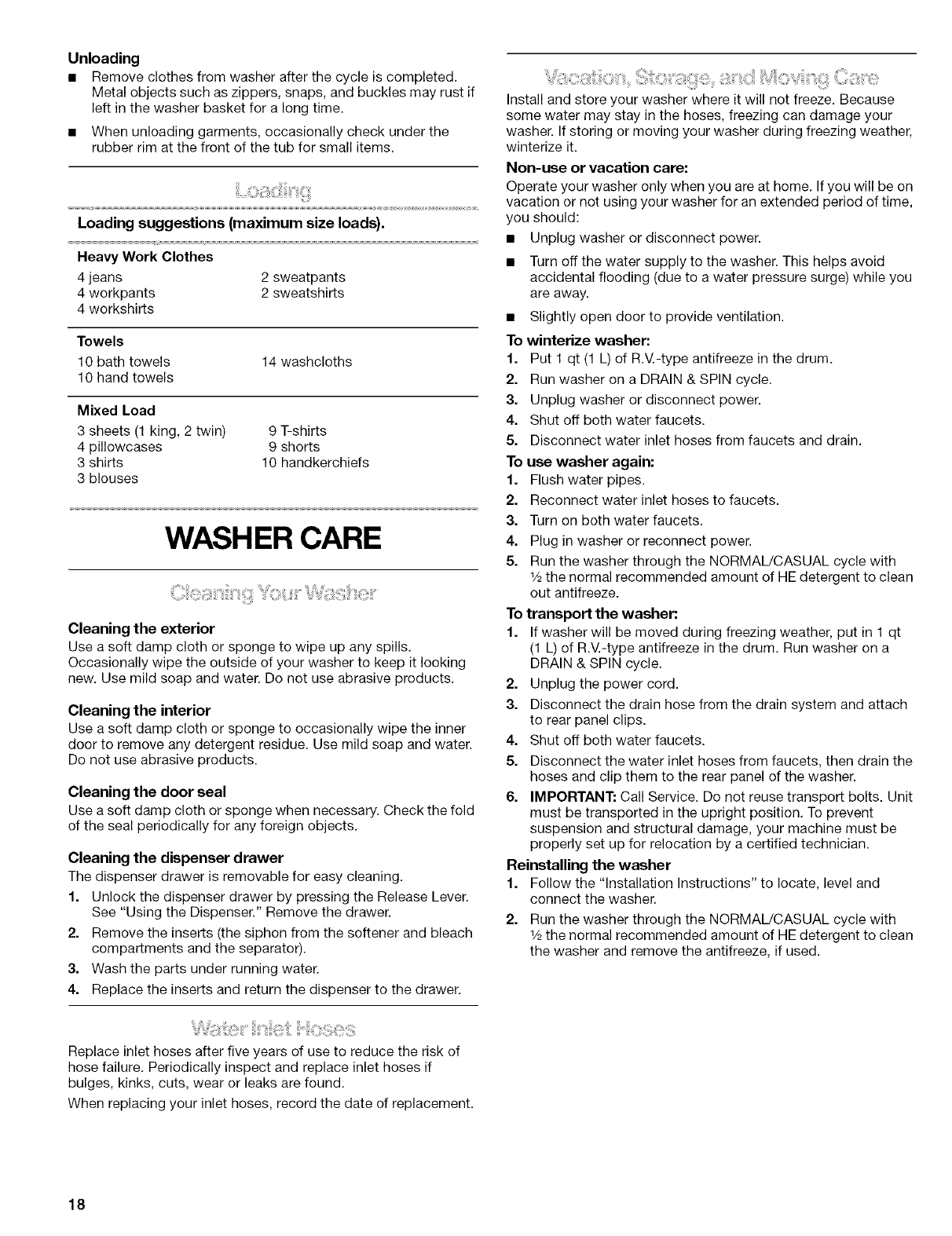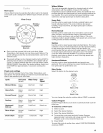
Unloading
• Remove clothes from washer after the cycle is completed.
Metal objects such as zippers, snaps, and buckles may rust if
left in the washer basket for a long time.
• When unloading garments, occasionally check under the
rubber rim at the front of the tub for small items.
Loading suggestions (maximum size loads).
Heavy Work Clothes
4 jeans 2 sweatpants
4 workpants 2 sweatshirts
4 workshirts
Towels
10 bath towels 14 washcloths
10 hand towels
Mixed Load
3 sheets (1 king, 2 twin) 9 T-shirts
4 pillowcases 9 shorts
3 shirts 10 handkerchiefs
3 blouses
WASHER CARE
Cleaning the exterior
Use a soft damp cloth or sponge to wipe up any spills.
Occasionally wipe the outside of your washer to keep it looking
new. Use mild soap and water. Do not use abrasive products.
Cleaning the interior
Use a soft damp cloth or sponge to occasionally wipe the inner
door to remove any detergent residue. Use mild soap and water.
Do not use abrasive products.
Cleaning the door seal
Use a soft damp cloth or sponge when necessary. Check the fold
of the seal periodically for any foreign objects.
Cleaning the dispenser drawer
The dispenser drawer is removable for easy cleaning.
1. Unlock the dispenser drawer by pressing the Release Lever.
See "Using the Dispenser." Remove the drawer.
2. Remove the inserts (the siphon from the softener and bleach
compartments and the separator).
3. Wash the parts under running water.
4. Replace the inserts and return the dispenser to the drawer.
Install and store your washer where it will not freeze. Because
some water may stay in the hoses, freezing can damage your
washer. If storing or moving your washer during freezing weather,
winterize it.
Non-use or vacation care:
Operate your washer only when you are at home. If you will be on
vacation or not using your washer for an extended period of time,
you should:
• Unplug washer or disconnect power.
• Turn off the water supply to the washer. This helps avoid
accidental flooding (due to a water pressure surge) while you
are away.
• Slightly open door to provide ventilation.
To winterize washer:
1. Put 1 qt (1 L) of R.V.-type antifreeze in the drum.
2. Run washer on a DRAIN & SPIN cycle.
3. Unplug washer or disconnect power.
4. Shut off both water faucets.
5. Disconnect water inlet hoses from faucets and drain.
To use washer again:
1. Flush water pipes.
2. Reconnect water inlet hoses to faucets.
3. Turn on both water faucets.
4. Plug in washer or reconnect power.
5. Run the washer through the NORMAL/CASUAL cycle with
1/2the normal recommended amount of HE detergent to clean
out antifreeze.
To transport the washer:
1. If washer will be moved during freezing weather, put in 1 qt
(1 L) of R.V.-type antifreeze in the drum. Run washer on a
DRAIN & SPIN cycle.
2. Unplug the power cord.
3. Disconnect the drain hose from the drain system and attach
to rear panel clips.
4. Shut off both water faucets.
5. Disconnect the water inlet hoses from faucets, then drain the
hoses and clip them to the rear panel of the washer.
6. IMPORTANT: Call Service. Do not reuse transport bolts. Unit
must be transported in the upright position. To prevent
suspension and structural damage, your machine must be
properly set up for relocation by a certified technician.
Reinstalling the washer
1. Follow the "Installation Instructions" to locate, level and
connect the washer.
2. Run the washer through the NORMAL!CASUAL cycle with
1/2the normal recommended amount of HE detergent to clean
the washer and remove the antifreeze, if used.
Replace inlet hoses after five years of use to reduce the risk of
hose failure. Periodically inspect and replace inlet hoses if
bulges, kinks, cuts, wear or leaks are found.
When replacing your inlet hoses, record the date of replacement.
18


















